Ellen and Jim Have a Blog, Too
We are two part-time academics. Ellen teaches in the English department and Jim in the IT program at George Mason University.


Pallisers 1:1-2: Coercion and Pursuit · 9 August 07
Dear Nick,
I much appreciate your comments on Pallisers 1:1, “The Coerced Match” and invite whoever else would like to watch the films with me and join in with us, to join in. (On Trollope-l we are going to read the Palliser novels in a row after we finish Orley Farm.)
I like your idea of suggesting let’s use Raven’s name as shorthand for the team that made the films. I’ll do that too. Cardwell makes a strong case for saying the screenplay writer was an important uniting element in TV dramas in the 1970s still, a left-over from radio. I too will call Plantagenet just Palliser (except in those rare moments in the film when there is another Palliser around who doesn’t have a title); once he succeeds to the Dukedom, let’s call him the Duke. Let’s also watch the particular actors’ performances. Culver is superb in the part given him; so too Donald Pickering as a George Saunders-Dolly Longstaffe type.
I was reading Raven’s Idea of a Gentleman tonight. It seems to me Raven’s Palliser embodies Raven’s idea of a gentleman. Raven says that the ideal of paid pious lipservice to but is and was in fact irrelevant. The ideal of the gentleman was a futile anachronism even in the 19th century. He says in our era we don’t even pay lipservice to it, and says “I nevertheless admire them deeply and find myself out of sympathy with an age which in essence rejects them. The plain fact remains that we are of our age, and that this age, properly understood, ha sno use and no regard for gentility.” Palliser’s deep gentleness of soul, his honorableness is laughed at. So we are not necessarily to agree with all these macho male scorn flouts of Grey (Bernard Brown) and Palliser (Philip lLatham). He says that being a gentleman usually requires you have a certain rank in society so you were brought up to be educated in this way, but does not in itself require any rank. It’s very different from being upper class which is a matter of prestige, power, rank, money, privilege, and manners. Raven presents a satire on his book on our modern (and probably this was true a century ago too) “distrust of personal excellence.” Palliser manifests personal excellence.
So although in Barber’s book Raven is quoted as identifying with Lady Glencora and seeing the epic story across the many episodes as hers, he clearly embodies his ethical ideals (and they are real if sort of skewed—if you read his book you see this) in Palliser.
Raven doesn’t himself care if Palliser is out of it socially. He himself never was much loved, and once he got older he lived in Deal with his brother and basically was not a socializing creature in society, but wrote, and read and ate, and drank (and had sex when he wanted freely), in evenings going to a pub where after a while he had a small following and enjoyed himself with a group of local cronies. Raven’s best novels are based on the social life he led for the first 35 years of his life, and Barber says what is the problem with his novels is he seems to have not carried on changing with the world after 1950 or so.
I agree the depiction of Griselda (Rachel Herbert) in the films is problematic, but I like it anyway. I like her gentleness. I think the idea is she’s bored with her husband and is attracted to this eager yearning young man, but no more than Lady Glen does she understand him. She’s willing to pretend to care about decimals, but she lacks courage and when appealed to by Palliser to buck the Duke and actually risk her position, she fails him. Just the way Alice (Caroline Mortimer) fails Lady Glencora (Susan Hampshire), though in Alice’s case, Alice does so because the bad memories of George’s (Gary Watson) flagrant cruel and corrupt treatment of her are part of her baggage so she won’t break social mores anymore since she’s been so badly hurt the first time. This is not Trollope’s Alice; it’s Raven’s.
The scene where Griselda fails Palliser and succumbs to the Duke’s bullying and Alice fails Lady Glen because she sees Lady Glen is lying and trying to use her just as George did are juxtaposed immediately next to one another.
You note that at the close of Pallisers 1:1, “The coerced Match,” Lady Glencora McClusky is last seen sobbing in Alice’s stairwell, frantic with grief, and the stairs become a barred prison:
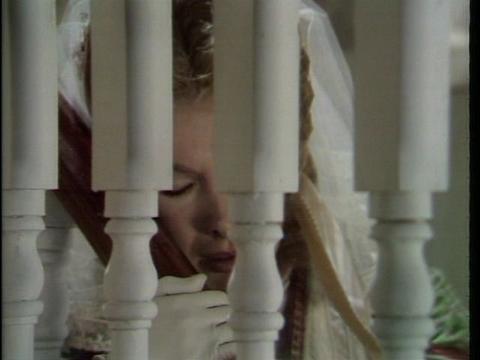
In Pallisers 1:2 (Volume 1, Part 2), Lady Glencora is against
photographed against a square which looks like a prison: this time
it’s the window at Matching Priory:
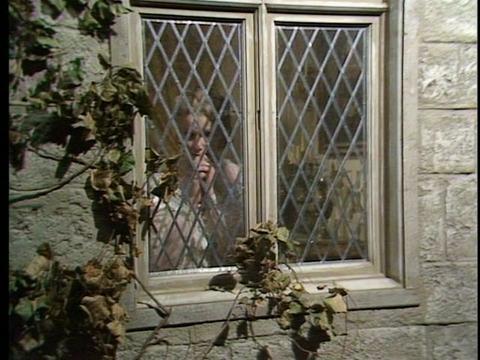
Now that I’ve watched the series to the end I can report that in 3:26 (Volume 3, Part 26), the aging Duke is photographed for a moment against the same window, looking out at Glencora’s grave.
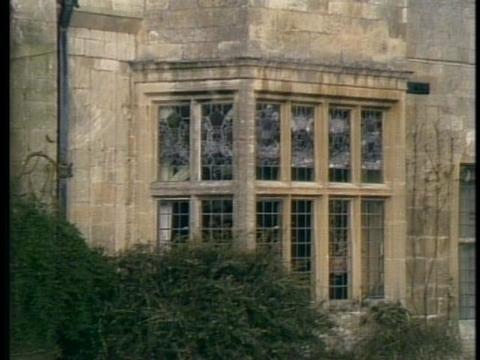
Duke of Omnium (Philip Latham) peering out decades later
I’ve watched on and agree Lady Glen is made a child, but I’d like to say that she is also presented as wanting to be safe and Palliser’s wife. When she visits Alice, after Alice refuses her, Lady Glen says “help me, Alice, I’m not strong enough,” and in context this means she’s not strong enough to break with Burgo (Barry Justice). In 2:1 he stalks her and she is mesmerized; she does not want to go to bed with Palliser or be ordered about by him, but she also fears Burgo. I suggest the film has it that Lady Glen has been given no viable choice for her and unlike Palliser no life’s work to satisfy her in compensation. She’s more than half-hysterical in 2:1; she’s like a mouse caught by two cats, one a proper one who will do his duty by her (the honorable gentleman), but also order her about and demand things of her she doesn’t like (the scene where she goes up to bed with Palliser is followed by a strong love scene between George and Alice which acts as a displacement of the sex we don’t see), the other someone she is deeply congenial with but doesn’t want either.
She’s a child with no place in this world. I’d say we are given a feeling she has integrity but doesn’t have any understanding of it; Alice has integrity and understands why she has it. This episode compare to 3:20-21 where Emily Wharton is stalked and seduced by Ferdinand Lopez only Emily is a sexy or highly sexualized adult-like young woman and really desires the sex Lopez gives her. Raven is laying bare the corrupt society Lady Glen flees in a way: as Palliser is sickened by the Duke who proposes to him marriage as a using of another human being as a beast and convenience and says he will remain faithful and takes his vows seriously, so Lady Glen covers her ears so her mind will not be polluted by her aunts who also insinuate she can have affairs readily once she marries:
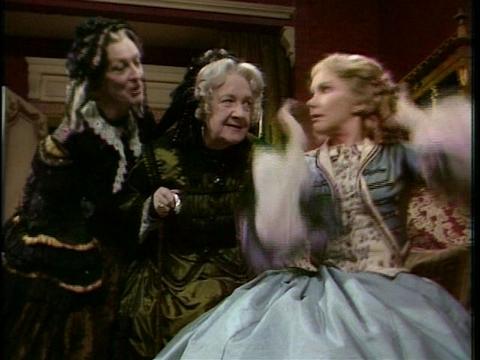
As long as there’s no scandal. Remember Lord Dumbello is probably Lady Hartletop’s son by the Duke of Omnium and everyone knows it and no one cares because no one says it aloud. The Duke wants Palliser to leave Lady Dumbello alone for the sake of his relationhip to Lady Hartletop so as to not open any skeletons in that closet. (In the Trollope’s Small House it’s clear the Grantlys knows Dumbello is not only the illegitimate son of the Duke but rejoice in it and don’t care if Dumbello spends his life in Paris gambling and having sex and in context that means he could carry syphilis and probably does—Trollope has quite a number of syphilitic lords in his novels).
Yes Adelaide, Marchioness Auld-Reekie (Sonia Dresdel) and Charlotte, Countess of Midlothian (Fabia Drake) are made to look like Victorias. I’ll close with a landscape postcard-like still from 1:2, the second episode, which shows us Palliser and Lady Glencora’s strained honeymoon and the Vavasour family trip to Switzerland:
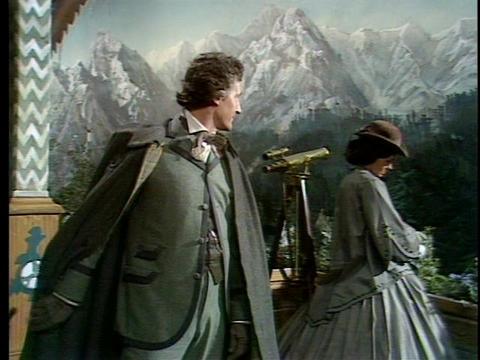
We see John Grey (Bernard Brown) turning to Alice Vavasour (Caroline Mortimer) to talk to her now that her father Mr John Vavasour (John Glyn-Jones) and Kate Vavasour (Karin MacCarthy) have left the terrace.
I want to make the point that the production designers chose colors and make different colors and lights dominate diferent episodes and scenes. I loved the Switzerland sequence for its use of white and greys and blues and greens. Not only do the stills and mise-en-scene project complicated themes, attitudes, ideas, moments and use objects symbolically; and not only are these juxtoposed and dissolved into one another and across series. The white is a restful escape but also a kind of death. Different parts have different colors which dominate and there are quite distinct palettes.
In 1:2 the colors are blue for the women and the palette background is white, grey and soft green. In 1:2 Raven has moved the plot-design to be more like Trollope’s: he drops the Widow Greenow and her suitors altogether and juxtaposes Alice v Grey & George Vavasour (Gary Watson) with Lady Glen v Palliser & Burgo Fitzgerald (Barry Justice_ so George and Burgo are stalking (in effect) the two women, pursuing them very aggressively, and the two women do not want the choices of either man on offer—with good reason, for then they cannot have a life of aspiration each one would prefer although neither is given anything but a man to aspire to (this last element is what is found in Trollope). But neither do they want the gentlemen owners they are offered.
In the picture Grey is dressed like the wanderers one finds in 19th
century romantic paintings of romantic poet-wanderers in vast sublime landscapes. Often they have a large stick and hat just like Grey’s and big cape too. George is also dresed like one of these picturesque supposed free spirits. Alice is dressed precisely like one of Millais’s illustrations for a later novel. The costumer designers of the costume dramas often imitate the older illustrations (though they tend to try to deny this).
Sylvia
P.S. The way I’ve been able to study these films is I have an vlnc viewer. It enables me to pause or stop the flow of the images and snapshot copies as well as study them or write very carefully. Ican in other words watch at a slower pace after I’ve watched the film through. There is just so much thrown at you, you can’t take it all in. Juxaposition and dissolving is essential to the thematic readings. I will not be able to keep up with Nick if he proceeds to 1:2 while I’m gone to Vermont. I’m nearly to the end of 2:1 and will finish (I hope) when I return and then post a blog about 1:2. I will probably have to go much slower too once I start teaching. But I’m in no hurry.
Jim watches with me on and off. He comes into the room and watches for a bit and then leaves, and then comes in again. He got a great kick out of Roland Culver’s performance of the Duke and suggested it was over-the-top ironic, a burlesque which was nonetheless meant to project the ruthless power of such a man, his amorality and cynicism. He suggested Trollope would not have laughed at the Duke and Raven wants us to laugh, partly because this really unqualified kind of power for a single man is gone. I should add Jim has read all the Palliser novels and The Way We Live Now. He says he doesn’t remember them very well but he does remember some things.
--
Posted by: Ellen
* * *
Comment
commenting closed for this article
